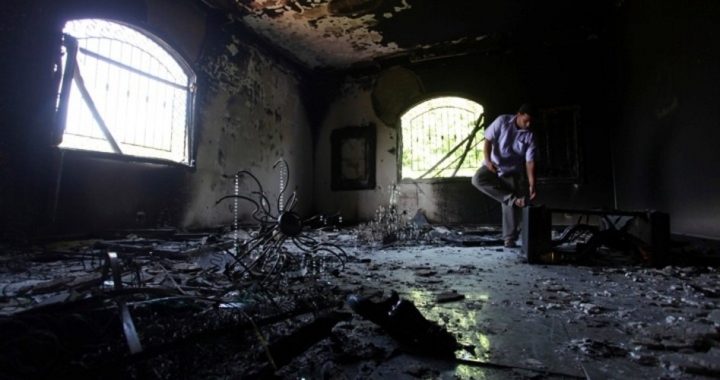
In its clumsy attempt to absolve President Obama and former Secretary of State Hillary Clinton from responsibility for the deadly attack in Benghazi, Libya, the New York Times has reignited intense scrutiny and debate over the fiasco and the administration’s lies and cover-ups in its aftermath.
On December 28, the Times opened a new chapter in the ongoing furor over “Benghazigate” with an extensive, 7,000-word article by David D. Kirkpatrick entitled, “A Deadly Mix in Benghazi.” According to Kirkpatrick, his article is the result of “months of investigation by The New York Times,” which “turned up no evidence that Al Qaeda or other international terrorist groups had any role in the assault.” Moreover, he says, the September 11, 2012 attack, which resulted in the murder of four Americans — Ambassador Stevens, Sean Smith, Glen Doherty, and Tyrone Woods — “was fueled in large part by anger at an American-made video denigrating Islam.”
It is not surprising that the Times, which has staunchly supported both President Obama and Hillary Clinton, would come to their aid once more, producing a piece that echoes and affirms the administration’s Benghazi talking points, even though the facts have discredited those talking points.
A number of critics have already pointed out that Kirkpatrick’s latest article is contradicted by earlier Times reports which acknowledge the al-Qaeda ties of some of the Libyan jihadist militias (that the Obama administration, incidentally, was supporting). See, for instance, Aaron Klein at World Net Daily here and here, and Thomas Joscelyn at The Weekly Standard here.
It is also contradicted by a detailed report prepared by the Library of Congress entitled, Al-Qaeda in Libya: A Profile, issued in August, 2012, the month before the fatal Benghazi attack.
It is also interesting that the Times would once again try to lay the blame for the attack on a spontaneous riot incited by the anti-Muslim video and protests over the video in faraway Cairo, Egypt. This, of course, is a resurrection of the Barack Obama/Susan Rice/Hillary Clinton false narrative issued immediately after the fatal attack, which was an effort to cover up the fact that the event was a highly coordinated terrorist attack carried out by some of the very jihadists the administration was arming and aiding. The spontaneous riot narrative was also aimed at diverting attention from the fact that Secretary Clinton had failed to heed repeated warnings from Ambassador Stevens and State Department security personnel about the escalating danger in Benghazi and their appeals for additional security.
However, no credible evidence has been produced to support the claim that the anti-Muslim video precipitated, or contributed to, the Benghazi attack. And an in-depth analysis by Agincourt Solutions, a prominent social media monitoring firm, could find none of the alleged Internet traffic and postings in the Benghazi region that were supposedly responsible for stirring up the attackers.
Pre-emptive Defense for Hillary’s 2016 Presidential Run
The most transparent reason for the Times’ flimsy Benghazi whitewash is that the paper was trying to divert attention from Secretary Clinton’s central role in the whole sordid affair, so that a festering Benghazigate scandal would not derail her White House hopes for 2016. Mrs. Clinton and her media cheerleading section hoped Benghazi had been laid to rest with the report issued by the Accountability Review Board (ARB) in December 2012. However, the ARB report was suspect from the start. Four of the panel’s five members were appointed by Clinton herself. The ARB chairman — appointed by Clinton — was former UN Ambassador Thomas Pickering, a longtime Washington Insider (Council on Foreign Relations member and director, Trilateral Commission member). The ARB neglected to ask some of the most obvious questions and failed to interview some of the most important figures — including Secretary Clinton! And, as usually happens in these investigations, the report refrained from assigning blame to President Obama, Secretary Clinton, or her top assistants; lower-level employees and vague “systemic failure” received the blame.
Clinton resigned her State Department post in January 2013, to be replaced by Sen. John Kerry, who had provided her with protective cover on Benghazi while serving as chairman of the Senate Foreign Relations Committee.
However, Benghazigate has refused to go away. Among the copious damning evidence to surface in recent months is the testimony of Eric Allan Nordstrom, the State Department’s regional security officer in Libya, before the House Committee on Oversight & Government Reform, on May 8, 2013. Nordstrom challenged many of the ARB report’s assertions, omissions, and failures. He pointed out, for instance, that Secretary Clinton herself was required by law (the Secure Embassy Construction and Counterterrorism Act of 1999, SECCA) to personally sign off on and respond to the security requests of the security personnel.
Nordstrom noted:
The protective measures for each post are dictated by the post’s overall threat level. At the time of the Benghazi attack, only a small number of the 264 overseas diplomatic posts were rated either HIGH or CRITICAL in threat categories related to political violence, terrorism, and crime. Our posts in Benghazi and Tripoli were among those posts and the only two facilities that met no OSPB or SECCA standards.
On September 16, 2013, House Oversight and Government Reform Committee Chairman Darrell Issa (R-Calif.) released an interim report focused on the conclusions of the State Department Accountability Review Board. The ARB had placed blame on mid-level officials but did not examine the role of more senior officials involved in security decisions.
Among the charges Rep. Issa leveled at the ARB report were:
“The ARB was not fully independent,” said Chairman Issa on releasing the report. “The panel did not exhaustively examine failures and it has led to an unacceptable lack of accountability….
The State Department obstructed the congressional investigation: The State Department’s refusal to turn over ARB documents has made an independent evaluation of the ARB’s review difficult. The ARB did not record or transcribe the interviews it conducted. The State Department is withholding interview summaries created by ARB staff.”
Hillary Clinton undoubtedly is happy that she left the Obama administration before the debacle of the ObamaCare rollout. She will be doing everything possible to distance herself from that albatross. However, President Obama’s repeated, blatant lies concerning healthcare (“If you like your doctor, you will be able to keep your doctor, period. If you like your health-care plan, you’ll be able to keep your health-care plan, period. No one will take it away, no matter what.”) have so destroyed his trust levels, that it is almost certain to also greatly affect public believability regarding his claims — and those of Secretary Clinton — concerning the deadly intrigue, criminal negligence, lies, and cover-ups involved in Benghazigate.
Photo at top shows inside of U.S. compound in Benghazi the day after the Sept. 11, 2012 attack: AP Images
Related articles:
Benghazi Backfire: Was Obama Arming Jihadists?
Benghazi “Whitewash” Report Still Damaging to Obama
Benghazi Report Ignores WH Lies, Obama Gunrunning to Jihadists
Benghazigate: The Disaster That Should Have Sunk Obama — and Still Could



